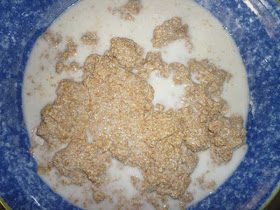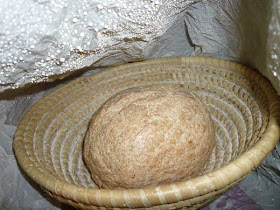My Take on Desem, week 3
Here is the 3rd week of Desem. I wanted to see if I could bake it larger, instead of dividing the dough. I also used store-bought whole wheat flour for the final bake, since I was beginning to think that the flour I was milling was not quite fine enough. So the starter in this bread is hand-milled, but the bulk of the flour (4 cups worth) is whole wheat flour purchased at Arva Flour Mills.
This desem was refreshed daily with 1/3 c of fresh hand-milled whole wheat flour, except on the last day before the bake, when I added 1 full cup. One quarter of the desem was then reserved, and I built the bread with the 3/4 desem. Here was the full feeding schedule (as far as I know it):
Start: Desem 215g of 2 week old desem
Tues: 50g wwflour, 25g water
Wed: 49g wwflour, 17g water
Thurs: forgot to measure ingredients. Desem at end of feeding was 418g. Possibly added 50g wwflour, 16g water?
Fri: 49g wwflour, 19g water
Sat: 47g wwflour, 19g water
Sun: This day I added the ingredients quite late in the day, in the evening rather than in the morning. There was a smell of acetone. 48g wwflour, 20g water
Mon: 47g wwflour, 19g water
Tues: 1c = 156g wwflour, 97g water
End: Desem 912g
Of the end product, I reserved 228g of desem for the next week's build. But I would not refresh next week's desem daily -- rather, I would follow The Laurel's Kitchen Bread Book's (LKBB) suggestion for a twice-weekly refresh, it seems somewhat less grueling.
Following the volume measurements of the Desem recipe in LKBB, I added the rest of the ingredients by weight:
- actual desem: 681g (I may have lost a few grams in the transfers from bowls)
- wwflour: 143g of hand-milled, 1359g storebought, for a total of 1502g
- sea salt: 18g
- water: 325g
Mis en place
Desem soaking in the lowest amount of water
Mixed as well as I could in the bowl: going to start to knead in a few minutes
Kneading after 5 min
Kneading after 10 min
Kneading after 15 min
Kneading after 20 min
Why was I keeping it so dry? My intention was to make a free-standing loaf, baked on a stone covered with a roasting pan, to simulate the casserole baking idea. A wetter dough, I felt, would not properly stand up to the freestanding size.
But a few other things went wrong anyway, as per my usual baking process.
First of all, I mixed this up after working nights, and fell asleep following putting the dough in a bowl for the bulk fermentation. This was only to have taken 4 hours, and I didn't get back to the dough until 6 1/2 hours had passed. That surprised me: this qualifies as a pretty good daytime sleep, for me. But of course, although I obviously needed it, my dough probably didn't. By then, the top of the loaf was quite dry.
Before I fell asleep: 0900
When I woke up: 1530
Folds
Instead of dividing the loaf into 2, I kept it whole and just pounded it down and tried to make the folds. This turned out to be not so pretty. The gluten cloak just tore everywhere. There was still some internal gluten structure that you could see through the tears, but this was very difficult to fold. Like when you are folding cardboard into smaller and smaller pieces, and the last few folds are not true folds but are more like imperfect bends.
Flatten out the dough
Fold it: look at that dry reptilian gluten cloak
Somehow manages to be a ball
End of the second folding: gondwanalike crust drift
After the 2 folds with a 15 minute rest in between, I let it sit in the basket, covered with a bag to keep the humidity in, within my warm excalibur dehydrator, for 1 1/2 hours before pre-heating the oven. It took the full 30 minutes to get to the proper temperature because I had so much paraphernalia in there: baking stones, pans for water, roasting pans.
All folded up, awaiting final 'proof'
Into the humidified bag
2 hours later: time to bake it
This ugly loaf is my 3rd attempt at Desem
Results:This is a spectacularly ugly loaf. The folds unfolded, leaving the loaf with ugly crevasses throughout.
I have tasted some this morning, however, and it tastes fine -- and unbelievably, it is still fairly moist, or at least, not as dense as some of the stale ends of loaves that I have hanging around. All in all, I'm impressed with the loaf's possibilities. Although I think that the crust has suffered somewhat from the uneven baking.
Thanks
Today is Thanksgiving Day in the U.S., and I have a lot of friends and relatives celebrating over there. For us in Canada, Thanksgiving has come and gone, and anyway it is not such a huge event here as it is in the South. But today, as I eat my Desem bread, despite all its ugliness and mistakes, I think of my friends, and give thanks for them; and I try, for this moment at least, to be grateful for the food that has come into my hands.
After all, any loaf you can eat when you are done baking cannot be a total failure.
My desem bread crumb: crust reveals an uneven baking
But it tastes fine
And it slices evenly
Notes to Myself
- Do it over. Too many mistakes to know where to begin.
- Give thanks for every bite.






















No comments:
Post a Comment